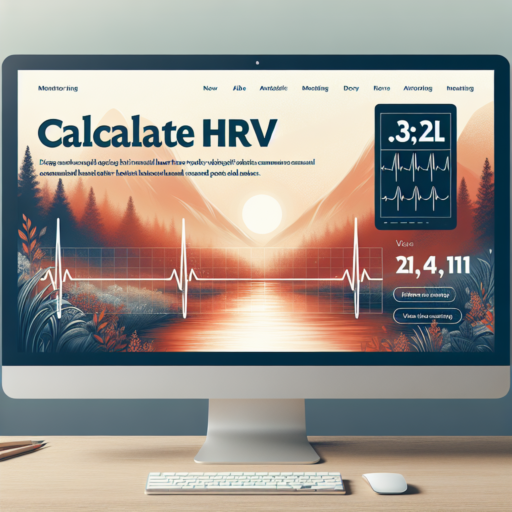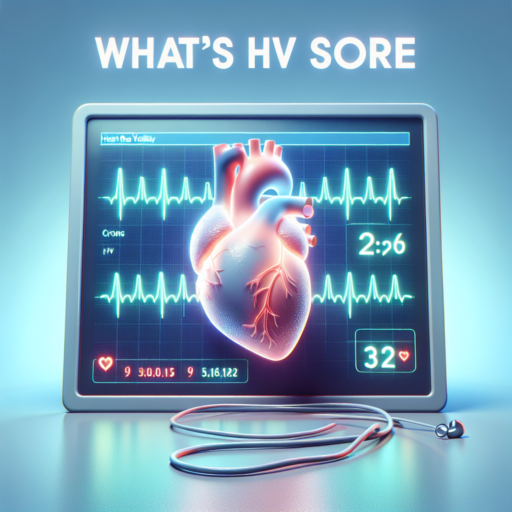Understanding the Basics of HRV: What It Is and Why It Matters
Heart Rate Variability (HRV) is an essential health marker that has garnered significant attention in the realms of fitness and wellness. At its core, HRV refers to the variation in time between each heartbeat, contrary to the common misconception that a healthy heart beats like a metronome. This variability is crucial because it reflects the body’s ability to adapt to stress, maintain balance, and essentially, how well the autonomic nervous system is functioning.
The significance of understanding HRV lies in its ability to offer a deep insight into one’s overall well-being and resilience. Higher levels of HRV indicate a robust and responsive autonomic nervous system, allowing the body to efficiently manage stress and recover from exercise. Conversely, lower HRV levels may suggest stress, overtraining, or underlying health issues. Thus, monitoring HRV can provide an early warning sign for potential health problems and offers an invaluable tool for fine-tuning training and recovery programs among athletes.
Moreover, the ease of tracking HRV has improved dramatically with advancements in wearable technology, making it accessible to not only athletes but anyone interested in optimizing their health. By understanding the basics of HRV, individuals can make informed decisions about lifestyle modifications that enhance their autonomic nervous system’s efficiency and, by extension, their overall health and well-being. This proactive approach to health monitoring underscores why HRV is a critical metric in the health and wellness industry today.
How to Calculate HRV: A Step-by-Step Guide
Understanding your Heart Rate Variability (HRV) is critical for assessing your body’s stress levels, recovery status, and overall heart health. Calculating HRV, however, can seem daunting for those unfamiliar with the process. This guide simplifies the calculation steps to help you effectively monitor your wellbeing.
Step 1: Gathering the Necessary Tools
Before you start, ensure you have a reliable heart rate monitor that records beat-to-beat intervals. A variety of apps are available that can analyze these intervals to provide your HRV scores. Choosing a device or app that suits your needs is imperative for accurate calculations.
Step 2: Recording Your Heart Beat Data
Wear your heart rate monitor and record your heartbeats preferably in the morning before any physical activity. This ensures your HRV reflects your body’s rest state. Most apps will require a minimum of a 2-5 minute recording to analyze your HRV accurately.
Step 3: Analyzing the Data
Once you have your heartbeat data, the app or device will use algorithms to calculate your HRV. The most common method used is the RMSSD (Root Mean Square of Successive Differences), which calculates the variability between heartbeats. Higher variability indicates better cardiovascular fitness and lower stress levels.
Calculating your HRV is a powerful tool for managing your health and fitness. With consistent monitoring, you can observe changes and patterns that can help you adapt your lifestyle for optimal wellness.
The Best Tools and Apps for HRV Calculation in 2023
In the evolving landscape of health technology, HRV (Heart Rate Variability) has emerged as a crucial metric for assessing one’s fitness and overall wellbeing. HRV refers to the variation in the time interval between heartbeats, a marker that can indicate the balance or imbalance in the body’s autonomic nervous system. As interest in personal health metrics grows, the demand for accurate and user-friendly tools for HRV calculation has also increased. In 2023, several standout apps and devices have made their mark on the market, offering users a blend of precision, ease of use, and insightful data analysis.
Noteworthy HRV Apps
Among the top contenders in HRV monitoring, certain apps have distinguished themselves for both iOS and Android users. Elite HRV and HRV4Training are notable for their comprehensive analytics and compatibility with external heart rate monitors. These apps not only calculate HRV but also provide detailed reports and recommendations personalized to each user’s physiology and goals. Their user-friendly interface and actionable insights make them exceptional tools for anyone looking to optimize their health and performance.
Leading HRV Wearables
In addition to stand-alone apps, wearable technology has also seen significant advancements in HRV tracking. Whoop Strap 3.0 and Garmin wearables stand out for their continuous HRV monitoring capabilities. These devices go beyond simple HRV calculation, offering features like sleep tracking, activity detection, and stress analysis, all designed to offer a holistic view of the user’s health. Their non-intrusive design and comprehensive health metrics make them invaluable assets for health enthusiasts and athletes alike.
Choosing the right HRV tracking tool can dramatically influence how individuals monitor and understand their health and fitness levels. Whether through a dedicated app or a multi-functional wearable, the tools and apps available in 2023 provide diverse options to suit different needs and preferences. As technology continues to advance, it is likely that the precision and functionality of HRV calculation tools will only improve, further embedding them into the daily health regimes of people worldwide.
Understanding Your HRV Results: What Your Numbers Mean
When delving into the complexities of your Heart Rate Variability (HRV) results, it’s essential to decode what the numbers are signaling about your overall health and fitness levels. HRV measures the variation in time between each heartbeat, which is closely tied to your autonomic nervous system’s performance. A higher HRV indicates a healthier, more resilient heart and nervous system, whereas a lower HRV can point to stress, fatigue, or underlying health issues.
Deciphering the Metrics: Typically, HRV scores are presented through several metrics, including but not limited to, RMSSD (the root mean square of the successive differences between heartbeats), LF/HF ratio (the balance between your sympathetic and parasygmenthetic nervous system), and SDNN (the standard deviation of NN intervals). Comprehending these figures can provide a deeper insight into your stress levels, recovery status, and cardiovascular health.
It’s pivotal to compare your HRV results within your personal context instead of against standardized benchmarks. Factors such as age, fitness level, and lifestyle choices significantly influence your HRV scores. Regular monitoring can help you understand your body’s unique patterns and rhythms, enabling you to make informed decisions about your health and well-being.
Improving Your HRV: Tips and Strategies for a Healthier Heart Rate Variability
Heart Rate Variability (HRV) is a critical measure of your autonomic nervous system functioning and overall heart health. A higher HRV indicates better cardiovascular fitness, stress resilience, and overall health. Incorporating simple lifestyle changes and strategies can markedly improve your HRV, enhancing your health and well-being.
Exercise Regularly for a Strong Heart
Regular physical activity is paramount for improving HRV. Engaging in a mix of aerobic exercises like running, swimming, or cycling, and strength training can greatly enhance your heart’s efficiency. It’s not just about the intensity, but consistency also plays a crucial role. Aim for at least 150 minutes of moderate-intensity or 75 minutes of high-intensity exercise weekly. However, it’s essential to listen to your body and avoid overtraining, as excessive strain can negatively impact your HRV.
Mind Your Sleep and Recovery
Sleep plays a foundational role in heart health and HRV. Ensuring you get sufficient, high-quality sleep every night allows your heart to recover and regulate stress hormones effectively. Establish a calming bedtime routine, keep your sleep environment cool and dark, and aim for 7 to 9 hours of restful sleep. Mindfulness practises like meditation and deep-breathing exercises before bed can significantly improve the quality of your sleep and, consequently, your HRV.
Incorporating these tips and strategies into your daily routine can lead to meaningful improvements in your HRV over time. Remember, gradual changes and consistency are key. Be patient and persistent, and your heart health will thank you.
HRV and Stress: How Monitoring Your HRV Can Help Manage Stress
Understanding the link between Heart Rate Variability (HRV) and stress is crucial in managing and mitigating the detrimental effects stress can have on the body. HRV, the variation in time between each heartbeat, is directly influenced by the autonomic nervous system (ANS), which regulates our stress response. Monitoring HRV can provide insightful data on how your body responds to stress and, more importantly, how to manage it effectively.
HRV functions as a mirror reflecting the state of balance between the sympathetic and parasythetic nervous systems. High HRV is often associated with good health and a resilient stress response system, indicating a strong ability to adapt to stress. Conversely, low HRV can signal poor stress management and a potential overload on the body’s physiological stress response mechanisms. By consistently tracking HRV, individuals can identify patterns and triggers of stress, paving the way for tailored stress management strategies.
Implementing regular HRV monitoring into your routine doesn’t just offer a snapshot of your stress levels; it empowers proactive measures towards stress reduction. Techniques such as breathing exercises, meditation, and lifestyle adjustments can be fine-tuned based on what HRV data reveals about your body’s stress response. This personalized approach to stress management not only enhances overall wellbeing but also improves your capacity to handle stress in the future.
The Connection Between HRV and Sleep: What You Need to Know
Understanding the intricate relationship between Heart Rate Variability (HRV) and sleep is essential for optimizing our wellbeing. HRV, the variation in time between consecutive heartbeats, is an important indicator of our autonomic nervous system’s health and our body’s ability to manage stress. The connection it shares with sleep is both profound and impactful on our daily lives.
HRV: A Mirror of Sleep Quality
Recent studies have shown that our sleep stages have a direct correlation with HRV patterns. During the restorative sleep phases, namely deep sleep, HRV tends to increase, indicating a state of relaxation and low stress. This increase in HRV plays a crucial role in the body’s night-time recovery processes, highlighting the importance of quality sleep in maintaining a healthy heart and nervous system.
The Impact of Poor Sleep on HRV
Conversely, poor sleep can lead to a decrease in HRV, suggesting heightened stress and a strain on the body’s recovery capabilities. This reduction in HRV can have several implications, including increased risk of cardiovascular diseases, fatigue, and reduced stress resilience. It underscores the need for not only adequate sleep but also the pursuit of improving sleep quality to maintain optimal HRV levels.
Exploring the connection between HRV and sleep equips individuals with valuable insights into their physiological state, encouraging interventions that can significantly enhance their health and well-being. By focusing on improving sleep, one anticipates not only a better HRV but also a stronger, more resilient body and mind.
How Athletes Use HRV to Enhance Training and Performance
Understanding the relationship between Heart Rate Variability (HRV) and athletic performance has become a game-changer in modern sports science. Athletes from a broad spectrum of disciplines are leveraging HRV to strategize their training regimens and optimize performance. HRV offers insights into the autonomic nervous system and how it responds to stress, rest, and recovery, enabling athletes to tailor their workouts with unprecedented precision.
One of the key ways athletes use HRV is to monitor their readiness for training. By analyzing variations in heart rate, athletes can gauge whether their body is fully recovered and ready for high-intensity training or if they need more rest. This approach helps in avoiding overtraining and reducing the risk of injuries. It ensures that every training session is conducted at the optimal time for physical development, making the training process both efficient and effective.
Moreover, HRV is pivotal in managing training load and intensity. Athletes employ HRV data to adjust their training intensity, duration, and frequency. High HRV readings indicate a well-rested body capable of handling strenuous workouts, while lower readings suggest the need for lighter, recovery-focused activities. This dynamic adjustment prevents burnout and enhances overall athletic performance by ensuring athletes train at their peak potential when it matters the most.
No se han encontrado productos.
HRV Trends: Understanding Long-Term Implications for Your Health
In recent times, the spotlight on Heart Rate Variability (HRV) and its trends has illuminated a unique perspective on our health and well-being. Recognizing the long-term implications of HRV trends can offer essential insights into your body’s response to stress, quality of sleep, and overall cardiovascular health. This discussion dives deep into why keeping an eye on these trends can be a pivotal component of your healthcare regimen.
HRV measures the variation in time between each heartbeat, which is considered a critical indicator of your autonomic nervous system’s efficiency. A higher HRV indicates better cardiovascular flexibility and resilience to stress, whereas lower HRV is often linked with stress, fatigue, or even poor health conditions. By understanding the fluctuations in your HRV, you can gain valuable information about your body’s stress levels and recovery state, making it easier to tailor your lifestyle to boost your health.
Monitoring HRV trends over time can reveal patterns that are otherwise not noticeable on a day-to-day basis. This is crucial for detecting subtle changes in your health that could signify the need for adjustments in your fitness routine, stress management techniques, or sleep habits. It’s an empowering tool that puts you in the driver’s seat of your health journey, providing actionable data that you can use to make informed decisions about your health and lifestyle.
Frequently Asked Questions About HRV Calculation
When it comes to understanding the nuances of Heart Rate Variability (HRV) calculation, many enthusiasts and professionals alike seek clarity. HRV, the measure of the variation in time between each heartbeat, is an important indicator of physical fitness and stress levels. The frequently asked questions below aim to shed light on the complexities of HRV calculation.
What Factors Influence HRV?
Several factors contribute to variations in HRV, including age, genetics, lifestyle, and current stress levels. It’s crucial to note that exercise, sleep quality, and mental health can significantly impact your HRV readings. Recognizing these factors is essential for accurate interpretation of HRV data.
How Is HRV Calculated?
The calculation of HRV involves analyzing the time intervals between heartbeats, known as RR intervals. These intervals are measured in milliseconds and can be affected by the autonomic nervous system’s regulation of the heart rate. Advanced algorithms and statistical methods, such as the Root Mean Square of the Successive Differences (RMSSD) and the Standard Deviation of NN Intervals (SDNN), are commonly used to quantify HRV from these intervals.




